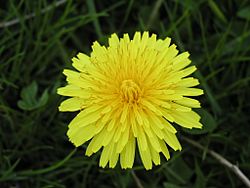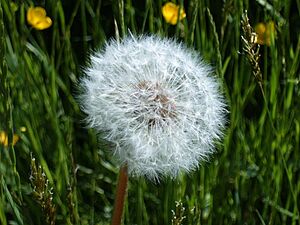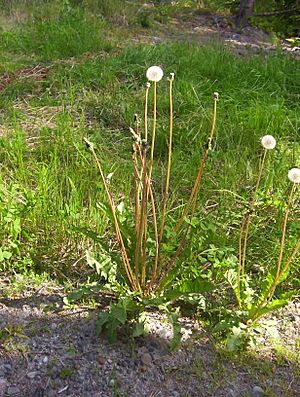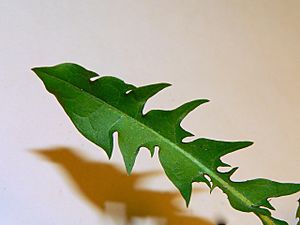Dandelion facts for kids
Quick facts for kids Dandelion |
|
|---|---|
 |
|
| A flowering dandelion | |
| Scientific classification | |
| Kingdom: | |
| Division: | |
| Class: | |
| Order: | |
| Family: | |
| Genus: |
Taraxacum
|

A dandelion is a common yellow flower. Its scientific name is Taraxacum. This is a large group of flowering plants in the Asteraceae family. Dandelions originally came from Eurasia and North and South America. Two types, T. officinale and T. erythrospermum, are now found all over the world as weeds. Interestingly, all parts of both these types are safe to eat!
Dandelion leaves have sharp edges that look a bit like a lion's teeth. This is how the plant got its name. Its seeds are like tiny parachutes. They fly away easily with the wind, helping new dandelions grow in many places. In China, dandelions have been used as medicine for a long time. Sometimes, dandelion pollen can cause allergies in people.
Like other plants in the Asteraceae family, dandelions have many tiny flowers grouped together. This group forms one large flower head. Each small flower in the head is called a floret. Many Taraxacum species make seeds without needing pollination. This process is called apomixis. It means the new plants are exactly like the parent plant.
People have known about dandelions for a very long time. An Arab scientist named Al Razi wrote about them around 900 A.D. Another Persian scientist, Ibn Sīnā, also wrote about Taraxacum around 1000 A.D.
Contents
What is a Dandelion?
Dandelions are perennial plants, which means they live for more than two years. They have a strong main root called a taproot. They are also herbaceous, meaning they have soft stems instead of woody ones. Dandelions grow naturally in cool parts of the Northern Hemisphere. There are many different types of dandelions. In the British Isles alone, there are 234 recognized types!
The leaves of a dandelion are usually 5–25 cm long or even longer. They are simple leaves with lobes, and they grow in a circle close to the ground. This circle is called a basal rosette. The bright yellow or orange flower heads open during the day and close at night. Each flower head grows on a single, hollow stem. This stem is usually smooth and leafless. It can grow from 1 to 10 cm or more above the leaves.
If you break a dandelion stem or leaf, a white, milky liquid called latex comes out. One plant can grow several flower stems at once. The flower heads are 2–5 cm wide. They are made up entirely of ray florets, which are the petal-like parts. After flowering, the heads turn into round, fluffy seed heads. These are often called blowballs or clocks. Each seed is called an achene. It has a pappus, which is a parachute of fine hairs. This helps the seeds float away on the wind for long distances.
The flower head has two layers of leaf-like parts called bracts. The inner bracts stand up straight until the seeds are ready. Then they bend down to let the seeds fly away. The outer bracts often bend downwards too.
How Dandelion Seeds Travel
Many types of dandelions spread their seeds easily. The common dandelion (T. officinale) is especially good at this. It quickly grows in disturbed soil all over the world. After a dandelion finishes flowering, its flower head dries out for a day or two. The dried petals fall off, the bracts bend back, and the fluffy seed ball opens up into a perfect sphere. Then, the wind carries the seeds far away.
Plants That Look Like Dandelions
Many yellow flowers in the Asteraceae family look like dandelions. People sometimes call them "false dandelions." For example, dandelions look a lot like catsears (Hypochaeris). Both plants have similar flowers that turn into wind-blown seeds. However, dandelion flowers grow alone on stems that are not branched, are smooth, and have no leaves. Catsear stems are branched, solid, and have small leaves. Both plants have a circle of leaves at the base and a main taproot. But dandelion leaves are smooth, while catsear leaves are quite hairy.
Early-flowering dandelions can also be confused with coltsfoot. You can tell them apart because dandelions have a basal rosette of leaves. Coltsfoot does not have these leaves on its flowering stem.
Other plants that look similar include hawkweeds and hawksbeards. You can easily tell these apart because their flowering stems are branched. They are also usually hairy and have leaves on the stem.
Different Types of Dandelions
People have grown special types of dandelions for eating. Here are a few:
- Amélioré à Coeur Plein: This type grows a lot of leaves without taking up much space. Its leaves tend to whiten naturally because they grow so close together.
- Broad-leaved: The leaves of this type are thick and soft. They are easy to whiten for eating. In good soil, they can grow up to 60 cm wide. These plants don't go to seed as quickly as French types.
- Vert de Montmagny: This type grows large leaves and grows strongly. It also matures early.
Dandelion History
Dandelions are believed to have first appeared about 30 million years ago in Eurasia. Scientists have found Fossil seeds of an ancient dandelion type, †Taraxacum tanaiticum, from a very old time period in southern Russia. Humans have used dandelions for food and as an herb for most of history. Ancient Egyptians, Greeks, and Romans knew about them. Chinese traditional medicine has used dandelions for over a thousand years. Dandelions probably came to North America on the Mayflower ship. They were brought on purpose because of their helpful medicinal uses.
What's in a Name?
The Latin name Taraxacum comes from old Persian writings about medicine. The Persian scientist Al-Razi wrote around 900 CE that "the tarashaquq is like chicory." Another Persian scientist, Ibn Sīnā, wrote a chapter about Taraxacum around 1000 CE. When Gerard of Cremona translated Arabic to Latin around 1170, he spelled it tarasacon.
The English name, dandelion, comes from the French words dent de lion. This means "lion's tooth." It refers to the dandelion's leaves, which have jagged, tooth-like edges. The plant has many other common names too. Some are blowball, cankerwort, doon-head-clock, milk witch, and puff-ball. Other names include pee-a-bed and wet-a-bed, which refer to its diuretic properties.
Dandelion Names Around the World
In Swedish, the dandelion is called maskros, meaning "worm rose." This is because of the tiny insects often found in the flowers. In Finnish and Estonian, the names (voikukka, võilill) mean "butter flower." This is due to the flower's yellow color. In Lithuanian, it's called "Pienė," which means "milky." This refers to the white liquid that comes out when the stems are cut. The names in Welsh (dant-y-llew), German (Löwenzahn), Norwegian (løvetann), and Spanish (diente de león) all mean "lion's tooth," just like the French and English names.
Amazing Dandelion Uses
Dandelions as Food
Dandelions are found on all continents. People have gathered them for food since ancient times. However, the types grown for eating mostly come from Eurasia. Since it's a perennial plant, its leaves will grow back if the main root is left in the ground. To make the leaves taste less bitter, they are often blanched (lightly cooked) or cooked like spinach. Dandelion leaves and buds have been part of traditional Kashmiri, Slovenian, Sephardic, Chinese, and Korean cuisines. In Crete, people eat the leaves of a local dandelion type called 'Mari' either raw or boiled in salads.
The flower petals, along with other ingredients like citrus, are used to make dandelion wine. The roots can be dried, roasted, and ground to make a dandelion coffee that has no caffeine. Dandelion was also traditionally used to make the British soft drink dandelion and burdock. It is also one of the ingredients in root beer. In the past, dandelions were even considered a special food eaten by wealthy people in Victorian times, often in salads and sandwiches.
Dandelion leaves are full of vitamins and minerals. They are especially rich in vitamins A, C, and K. They are also good sources of calcium, potassium, iron, and manganese.
Dandelions and Your Health
Historically, dandelions were valued for their many helpful properties. They contain several compounds that can affect the body. Dandelion is used as a herbal remedy in Europe, North America, and China. It has been used in herbal medicine to help with infections, bile and liver problems, and as a diuretic (something that helps the body get rid of extra water).
Dandelions and Wildlife
Taraxacum seeds are an important food source for certain birds. Dandelions are also very important plants for bees in the Northern Hemisphere. They provide a vital source of nectar and pollen early in the spring. Dandelions are also food plants for the larvae (young forms) of some Lepidoptera species, which include butterflies and moths. They are also a source of nectar for the pearl-bordered fritillary, one of the first butterflies to appear in spring.
Dandelions in the Garden
The dandelion plant can be a beneficial weed. It has many uses and is even a good companion plant for gardening. Its taproot can bring up nutrients from deep in the soil for plants with shallower roots. It also adds minerals and nitrogen to the soil. Dandelions are also known to attract pollinating insects and release a gas called ethylene, which helps fruit ripen.
Dandelions in Culture
Four dandelion flowers are the symbol of White Sulphur Springs, West Virginia. The people there celebrate spring with an annual Dandelion Festival. The dandelion is also the official flower of the University of Rochester. "Dandelion Yellow" is one of the school's official colors. "The Dandelion Yellow" is also an official song of the University of Rochester.
Things to Watch Out For
Dandelion pollen might cause allergic reactions if eaten. Some people might also have skin reactions if they are sensitive to it. Skin irritation after touching dandelions has been reported. This is likely from the latex in the stems and leaves. Because dandelions have a high potassium level, they can increase the risk of too much potassium in the body if taken with certain medicines.
Dandelions as Weeds

The common dandelion (T. officinale) is listed as a noxious weed in some places. It is often seen as a problem in lawns and parks in North America. It is also a significant weed in farming. It can cause a lot of economic damage because it grows in many crops around the world.
Dandelions and Rubber
Dandelions produce latex when their tissues are cut. In wild dandelions, the amount of latex is usually low. However, scientists in Germany have developed a special type of dandelion. This type is good for making natural rubber for commercial use. The latex from these dandelions is just as good as the natural rubber from rubber trees. A company called Continental Tires is working with these scientists to build a special facility. As of 2014, the first test tires made with dandelion rubber were planned to be tested on roads.
Related pages
Common dandelion, a common herbaceous perennial plant.
Images for kids
-
These are individual pollen grains of the dandelion - Taraxacum officinale.
-
Field with flowering dandelions, Tatarstan, Russia
-
A Taraxacum officinale seedhead with only one seed still attached
-
Dandelion in Iran
-
Hand-coloured print, plate 1 of Dens Leonis in A Curious Herbal, 1737, by Elizabeth Blackwell
-
1679 hand-coloured print by Maria Sibylla Merian of a dandelion serving as a plant host to the pale tussock moth
See also
 In Spanish: Taraxacum para niños
In Spanish: Taraxacum para niños














